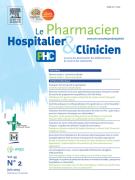Optimisation de la cotation et valorisation des actes à partir des prescriptions médicales hospitalières - 12/12/17
 , N. Poletto a, D. Bichard a, A. Dussaucy b, V. Nerich a, M.C. Antraigue b, S. Limat a
, N. Poletto a, D. Bichard a, A. Dussaucy b, V. Nerich a, M.C. Antraigue b, S. Limat a| pages | 9 |
| Iconographies | 4 |
| Vidéos | 0 |
| Autres | 0 |
Résumé |
Introduction |
Depuis la tarification à l’activité, la cotation des actes est un enjeu majeur pour les hôpitaux. Par son activité de pharmacie clinique, la pharmacie hospitalière peut être un atout ; un médicament pouvant être caractéristique d’une comorbidité médicale associée (CMA). L’objectif est d’évaluer un modèle d’identification des CMA à travers les prescriptions médicales.
Matériels et méthodes |
Une extraction des séjours où les prescriptions contenaient un ou plusieurs médicaments d’un référentiel associant médicaments–CMA a été réalisée sur 10 mois. Deux axes ont été étudiés : une étude théorique comparant les données extraites avec celles du département d’information médicale puis une analyse de robustesse du modèle sur un échantillon.
Résultats |
L’ajout d’une comorbidité permet d’augmenter le niveau du séjour dans 28 % des cas pour un gain théorique annuel de 869 000 €. L’analyse en vie réelle (n=15) montre une concordance de 53 % dans la cotation des séjours pour une valorisation réelle de 10 777 € soit une extrapolation à 460 534 € pour un an (soit 767 557 € si 100 % de services informatisés).
Discussion/Conclusion |
Ce projet s’inscrit dans une logique d’amélioration de cotation des séjours et constitue une étude originale de collaboration entre la pharmacie et le département d’information médicale. La variabilité des pratiques et les utilisations hors AMM constituent les principaux freins et l’absence de données dans le dossier médical empêche une cotation idéale.
Le texte complet de cet article est disponible en PDF.Summary |
Introduction |
Since the introduction of the activity-based payment system, the pricing of medical acts has become a major issue for hospitals. The clinical pharmacy activity of the hospital pharmacy can be contributive, certain drugs being specific to an associated medical comorbidity (AMC). The objective of the present study was to assess a model of AMC identification based on medical prescriptions.
Methods |
Hospital stays for which the corresponding prescriptions contained one or more drugs associated to an AMC were recorded over a 10-month period. The study comprised two axes: a theoretical study compared the data thus retrieved and data from the hospital's department of medical information; model robustness was then assessed on a sample of hospital files.
Results |
The pricing of a given hospital stay was increased by including AMCs in 28% of cases, for a theoretic annual gain of €829,000. Real-life robustness analysis (n=15 files) showed 53% concordance in hospital stay pricing, for a real added value of €10,777, extrapolated to €460,534 for 1 year (€767,557 if all departments are computerized).
Discussion/Conclusion |
This project contributed to improving the pricing of hospital stays, in an original study of teamwork between the clinical pharmacy and the department of medical information. Variations in practice and off-label drug use constitute the main obstacles for the development of this tool. Lack data in medical records prevents optimal pricing.
Le texte complet de cet article est disponible en PDF.Mots clés : Comorbidités, Cotation, Information médicale, Pharmacie hospitalière
Keywords : Comorbidities, Pricing, Medical information, Hospital pharmacy
Plan
Vol 52 - N° 4
P. 339-347 - décembre 2017 Retour au numéroBienvenue sur EM-consulte, la référence des professionnels de santé.
L’accès au texte intégral de cet article nécessite un abonnement.
Bienvenue sur EM-consulte, la référence des professionnels de santé.
L’achat d’article à l’unité est indisponible à l’heure actuelle.
Déjà abonné à cette revue ?

